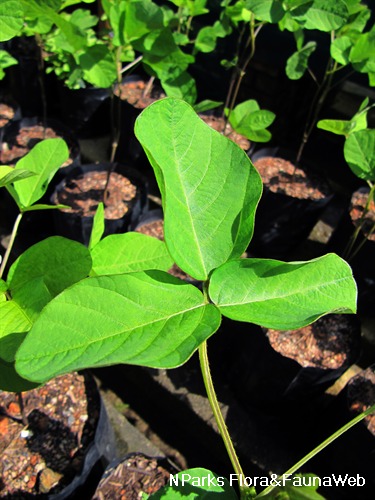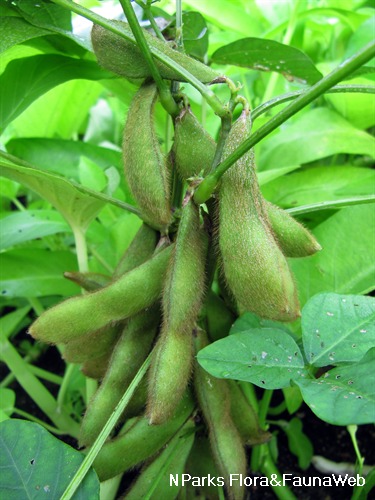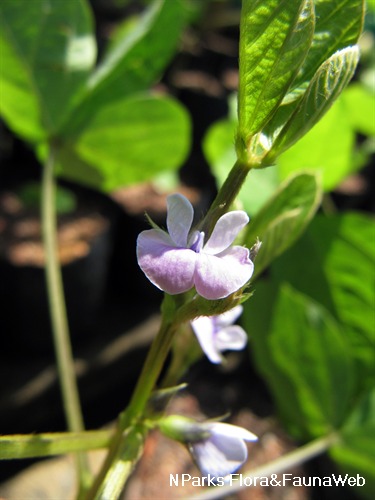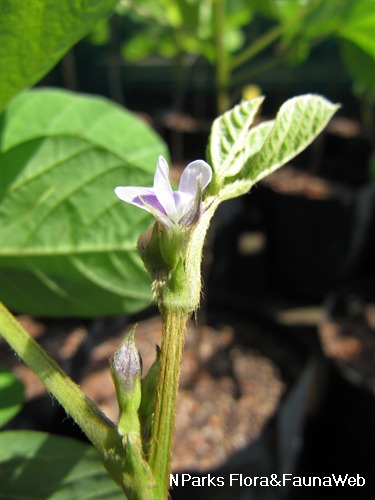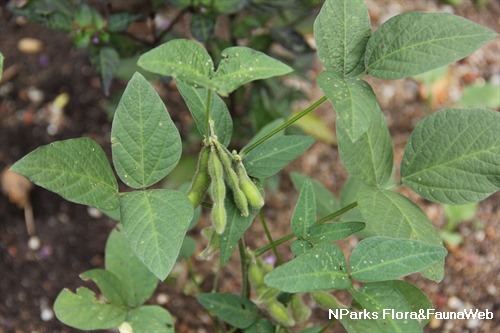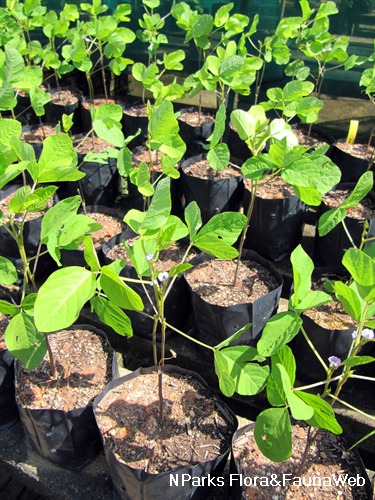
Name
Classifications and Characteristics
| Plant Division | Angiosperms (Flowering Seed Plants) (Dicotyledon) |
|---|---|
| Plant Growth Form | Herbaceous Plant |
| Lifespan (in Singapore) | Annual |
| Mode of Nutrition | Autotrophic |
| Plant Shape | Shrubby |
| Chromosome Number | 40 |
| Maximum Height | 0.9 m to 2 m |
Biogeography
| Native Distribution | East Asia |
|---|---|
| Native Habitat | Terrestrial |
| Local Conservation Status | Non-native (Horticultural / Cultivated Only) |
Description and Ethnobotany
| Growth Form | Annual herb up to 2 m tall, but cultivars are commonly 0.3-0.9 m tall. |
|---|---|
| Foliage | The leaves are pinnately trifoliate and are alternately arranged along the stem. The leaflets are green and have net venation, an entire margin and a mucronate leaf apex. The leaves are covered with a thin layer of hairs. |
| Flowers | The white to purple flowers are borne on irregular racemes which originate from the axillary buds on the stems. |
| Fruit | The fruits are pods or legumes which turn from green to yellow-brown in colour when ripe. Each pod yields 2 to 3 seeds. When the ripe beans are ready for harvest, the leaves will start to fall off, leaving the brown stems and the pods. |
| Cultivation | It is ideally grown under full sun and in well drained fertile soil. It can also be grown in acidic soil. When grown in rows, a distance of 5cm to 2.5cm in between the seeds would be ideal. Close spacing encourages the growth of the plants and helps in the control of weeds. Harvest the pods by cutting of the plants at ground level. |
| Ethnobotanical Uses | Edible Plant Parts : Edible Seeds Food (Fruit or Vegetable): Soybean is one of the world's most important sources of food and protein. The processed seeds give soy milk, a valuable protein supplement as well as other soy food stuffs such as soy beancurd. Soy sauce is made from matured fermented beans. Soybean is also eaten cooked as a vegetable. Agriculture - Forestry: Soybeans are planted as a cover crop which suppresses weeds. Others: Soy meal is also used as protein-rich animal fodder. |
Landscaping Features
| Landscape Uses | Parks & Gardens, Small Gardens |
|---|---|
| Thematic Landscaping | Economic Garden |
Plant Care and Propagation
| Light Preference | Full Sun |
|---|---|
| Water Preference | Moderate Water |
| Propagation Method | Seed |
| Propagation Method Remarks | Seeds should be pre-soaked in water before being planted. |
| Seed / Spore Germination Duration | 14 days |
Foliar
| Foliage Retention | Evergreen |
|---|---|
| Mature Foliage Colour(s) | Green |
| Mature Foliage Texture(s) | Hairy / Hirsute |
| Foliar Type | Compound (Trifoliate) |
| Foliar Arrangement Along Stem | Alternate |
| Foliar Attachment to Stem | Petiolate |
| Foliar Shape(s) | Non-Palm Foliage |
| Foliar Venation | Pinnate / Net |
Non - Foliar and Storage
| Root Type | Underground (Tap Root) |
|---|---|
| Root Symbiosis | Bacterial Nodulation |
Floral (Angiosperm)
| Flower & Plant Sexuality | Bisexual Flowers |
| Flower Colour(s) | White, Purple |
|---|---|
| Flower Grouping | Solitary, Cluster / Inflorescence |
| Flower Location | Axillary |
| Flower Symmetry | Bilateral |
| Individual Flower Shape | Papilionaceous / Pea-shaped |
| Inflorescence Type | Raceme |
Fruit, Seed and Spore
| Mature Fruit Colour(s) | Yellow / Golden, Brown |
|---|---|
| Mature Fruit Texture(s) | Hairy / Hirsute |
| Fruit Classification | Simple Fruit |
| Fruit Type | |
| Mature Seed Colour(s) | Black, Cream / Off-White, Red, White |
| Mature Seed Texture(s) | Smooth |
| Seed Quantity Per Fruit | Few (1-5) |
Image Repository
Others
| Master ID | 31372 |
|---|---|
| Species ID | 5769 |
| Flora Disclaimer | The information in this website has been compiled from reliable sources, such as reference works on medicinal plants. It is not a substitute for medical advice or treatment and NParks does not purport to provide any medical advice. Readers should always consult his/her physician before using or consuming a plant for medicinal purposes. |

